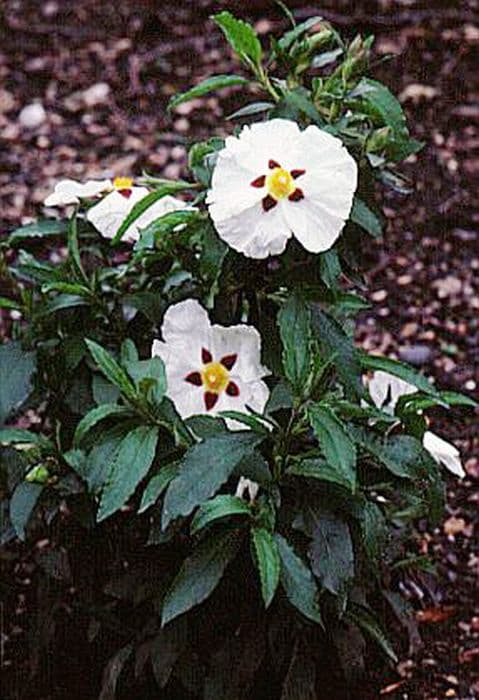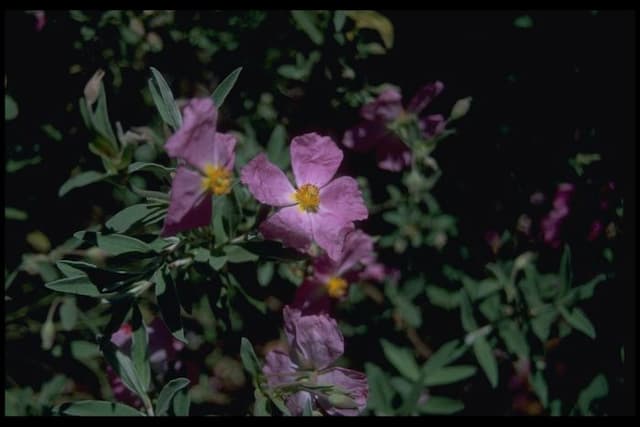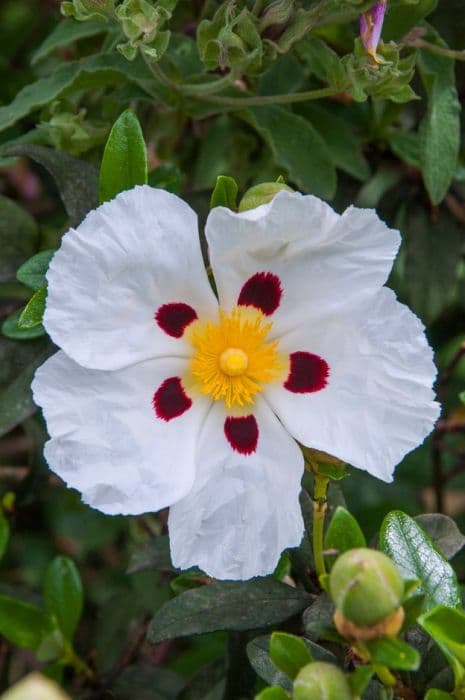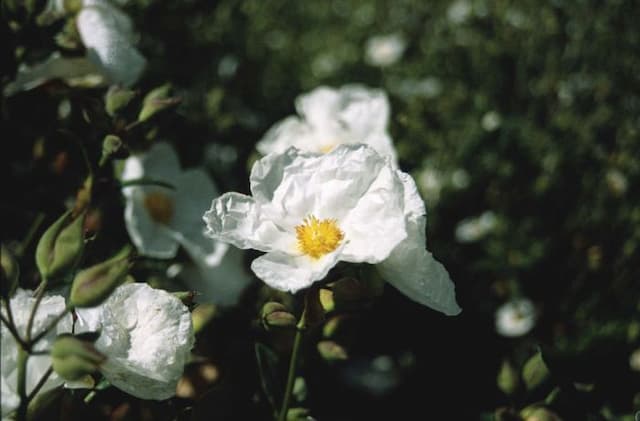Rock Rose Helianthemum 'The Bride'

ABOUT
The plant known as 'The Bride' is a charming species that features a delightful contrast of foliage and flowers. The leaves have a silvery-green hue that provides a soft, muted backdrop. They are small and lance-shaped with a somewhat fuzzy texture, creating an eye-pleasing mat of greenery. The true spectacle of 'The Bride' is its flowers. Each bloom is a single, cup-shaped wonder – pure white and glossy, with a bounty of petals that are softly rounded. At the heart of each flower lies a cluster of bright yellow stamens, adding a pop of color that draws in the eye and gives the appearance of a sunny disposition. This plant exudes a romantic and delicate aura, with its flowers appearing to float above the greenery like brides adorned in white gowns. The bloom period brings forth an enchanting display that captivates any onlooker. Between the blooms and the foliage lies the plant’s woody base, from which the flowering stems rise gracefully, contributing to its overall robust and resilient nature.
About this plant
 Names
NamesFamily
Cistaceae
Synonyms
Rock Rose, Sunrose
Common names
Helianthemum 'The Bride'.
 Toxicity
ToxicityTo humans
The Rock Rose 'The Bride' is not commonly known for being toxic to humans. There are no significant symptoms of poisoning associated with ingestion of this plant because it is not considered harmful to people. However, as with any plant, individual allergies or sensitive reactions could occur, so it is advised not to consume plant parts without confirming their safety.
To pets
The Rock Rose 'The Bride' is not commonly known for being toxic to pets. It is generally considered safe for animals and there are no significant symptoms of poisoning reported with its ingestion. However, individual pets can have unique reactions to any plant, and it's always best to prevent pets from eating plants that are not intended for them.
 Characteristics
CharacteristicsLife cycle
Perennials
Foliage type
Evergreen
Color of leaves
Green
Flower color
White
Height
1 foot (0.3 meters)
Spread
2 feet (0.6 meters)
Plant type
Shrub
Hardiness zones
5
Native area
Mediterranean
Benefits
 General Benefits
General Benefits- Attracts Pollinators: Invites beneficial insects like bees and butterflies due to its nectar-rich flowers.
- Drought Tolerance: Once established, it requires minimal watering, making it ideal for low-maintenance gardening and areas prone to dry conditions.
- Ground Cover: Its low-growing habit helps suppress weeds and cover bare spots in the garden.
- Decorative Blooms: Produces a profusion of white flowers that can enhance the aesthetic appeal of garden beds and borders.
- Sun Loving: Thrives in full sun, making it a great choice for sunny landscapes where other plants might struggle.
- Rock Garden Suitability: Ideal for rock gardens or alpine settings due to its compact size and preference for well-drained soil.
- Seasonal Interest: Offers a burst of blooms typically in spring and early summer, providing seasonal color when many other plants are not yet in flower.
- Easy Propagation: Can be easily propagated from cuttings or division, allowing gardeners to expand their planting without additional cost.
- Winter Hardiness: Capable of surviving through cold seasons in many climates, depending on the hardiness zone.
- Evergreen Foliage: Provides year-round interest with its evergreen leaves, even when not in bloom.
 Medical Properties
Medical PropertiesThis plant is not used for medical purposes.
 Air-purifying Qualities
Air-purifying QualitiesThis plant is not specifically known for air purifying qualities.
 Other Uses
Other Uses- Dye Production: 'The Bride' petals can be used to create a natural yellow dye for fabrics or crafting projects.
- Photography Prop: The plant can serve as an attractive backdrop or focus in plant photography, thanks to its bright white flowers.
- Educational Tool: The growth habits and drought tolerance of 'The Bride' can be used to educate students and gardeners about xeriscaping and water-saving gardening techniques.
- Culinary Garnish: Its edible flowers can be used to add a decorative touch to salads and desserts, although they should be used sparingly due to their intense flavor.
- Artistic Inspiration: Artists and crafters may cultivate 'The Bride' for inspiration, deriving color palettes or design elements from its flowers and foliage.
- Scented Sachets: Dried flowers of 'The Bride' can be placed in small pouches to create natural scented sachets for drawers or closets.
- Potpourri Ingredient: Combined with other dried flowers and spices, 'The Bride' can contribute to a homemade potpourri mix.
- Homemade Cosmetics: The flowers can sometimes be used in homemade beauty products such as bath bombs or natural soaps for their color and mild fragrance.
- Floral Crafts: The bright blooms can be incorporated into floral crafts such as wreaths or dried flower arrangements.
- Theme Gardens: 'The Bride' can be an element in a white-themed garden, creating a serene monochromatic display influenced by its white blossoms.
Interesting Facts
 Feng Shui
Feng ShuiRock Rose is not used in Feng Shui practice.
 Zodiac Sign Compitability
Zodiac Sign CompitabilityRock Rose is not used in astrology practice.
 Plant Symbolism
Plant Symbolism- Resilience: Helianthemum 'The Bride', commonly known as the Rock Rose, is a symbol of resilience because it thrives in rocky, arid environments and can withstand drought.
- Beauty and Purity: The white flowers of 'The Bride' resemble bridal attire, evoking purity and the beauty of traditional weddings.
- Endurance: As a plant that can live through tough conditions, Rock Rose represents endurance and the ability to persist in the face of challenges.
- Hope: Rock Rose often blooms in adverse conditions, symbolizing hope and the promise of renewal even during difficult times.
 Water
WaterRock rose 'The Bride' generally prefers a drier soil and tolerates drought well once established. Water the plant deeply but infrequently, providing about one to two gallons every two weeks during the active growing season, depending on weather conditions. Always allow the topsoil to dry out between waterings to prevent root rot. During winter, reduce watering significantly, and only water if the soil is completely dry and the plant shows signs of stress due to lack of moisture.
 Light
LightRock rose 'The Bride' thrives in full sun, requiring at least six hours of direct sunlight each day. The ideal spot for this plant would be in an area where it is exposed to ample sunshine throughout the day, which will encourage better flowering and healthy growth.
 Temperature
TemperatureRock rose 'The Bride' enjoys warm temperatures and can tolerate a range from approximately 30 to 90 degrees Fahrenheit. However, the plant's ideal temperature range is between 60 and 80 degrees Fahrenheit where it can grow most vigorously. It can withstand a light frost, but extended periods of cold below 30 degrees Fahrenheit can be damaging.
 Pruning
PruningRock rose 'The Bride' should be pruned to maintain its shape and remove any dead or damaged branches. Light pruning in early spring encourages new growth and can help promote a bushier form. Additionally, deadheading the spent blooms can encourage a second flush of flowers. Pruning is usually done once a year after the flowering season.
 Cleaning
CleaningAs needed
 Soil
SoilRock Rose 'The Bride' thrives in well-draining soil with added gravel or sand for increased drainage. Aim for a soil pH of 6.0-7.5. Use a combination of loam, peat, and coarse sand to create the optimal soil mix.
 Repotting
RepottingRock Rose 'The Bride' does not need frequent repotting and can be repotted every 2-3 years or when it outgrows its current pot.
 Humidity & Misting
Humidity & MistingRock Rose 'The Bride' prefers low to moderate humidity levels and can tolerate drier conditions typical of its Mediterranean origin.
 Suitable locations
Suitable locationsIndoor
Ensure full sun, well-draining soil, and minimal water.
Outdoor
Plant in sunny spot, well-draining soil, protect from harsh winter.
Hardiness zone
5-9 USDA
 Life cycle
Life cycleThe life of the Rock Rose 'The Bride' begins with germination, which typically occurs in early spring when the soil warms and moisture is adequate. Following germination, seedlings establish themselves and grow rapidly, forming a low, dense shrub with woody stems. Throughout late spring and into summer, the Rock Rose 'The Bride' enters the flowering stage, producing numerous white, crepe-paper-like flowers that attract pollinators. After pollination, the flowers give way to seed capsules that mature and release seeds, completing the reproductive cycle. In fall, the plant prepares for dormancy as growth slows and above-ground parts may die back in colder climates, though the roots remain alive underground. Come spring, the Rock Rose 'The Bride' will resume growth from its root system, reinitiating the cycle.
 Propogation
PropogationPropogation time
Spring-Early Summer
Helianthemum 'The Bride', commonly known as the rock rose, is often propagated through the method of semi-ripe cuttings. The best time to do this is in late summer. To propagate rock roses using this method, one selects a healthy, semi-ripe stem from the current year's growth. The stem should be about 4 to 6 inches (10 to 15 centimeters) long. The leaves from the lower half of the cutting are removed, and the cut end can be dipped in rooting hormone to encourage root development. This cutting is then placed in a pot with a mixture of equal parts peat and perlite or sand to provide good drainage. The pot should be kept in a warm place with indirect sunlight and the soil should be kept moist but not soaked. Roots typically develop within a few weeks, after which the new rock rose plant can eventually be transplanted to its final position.









